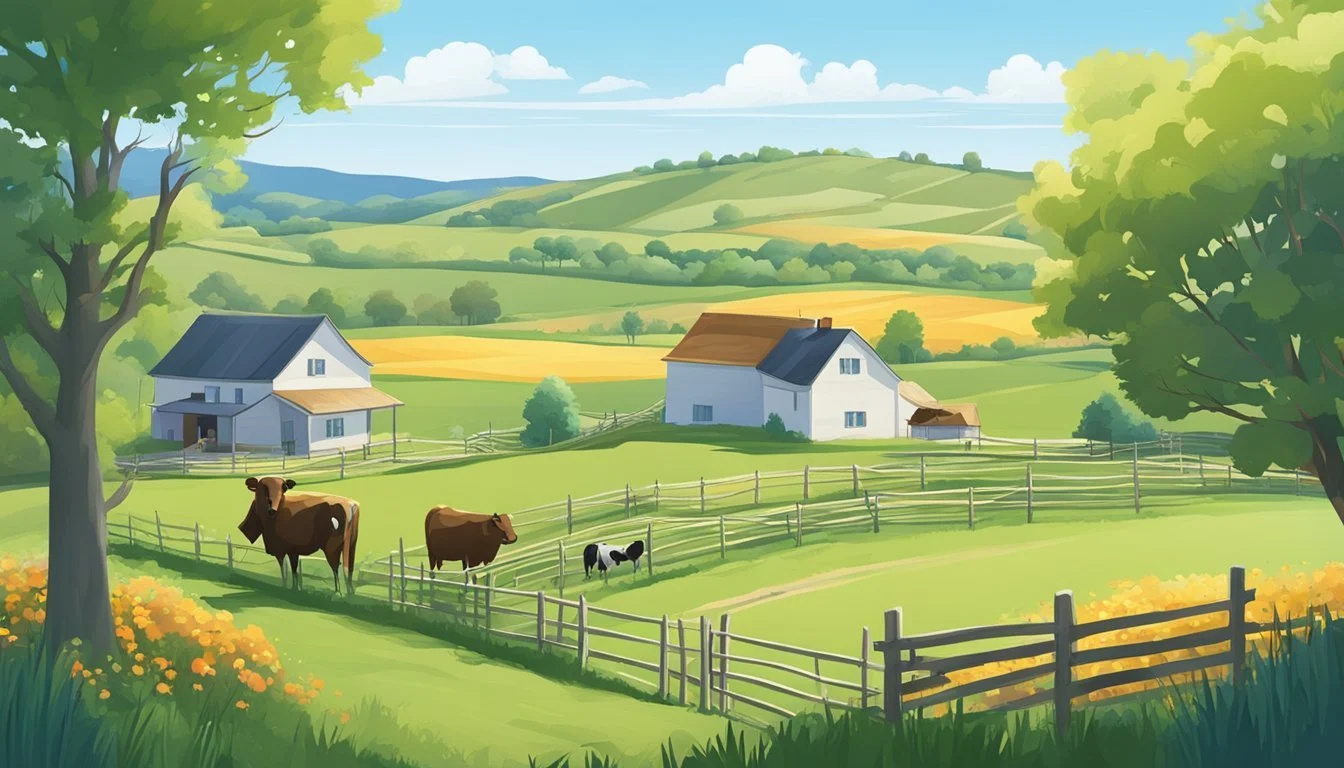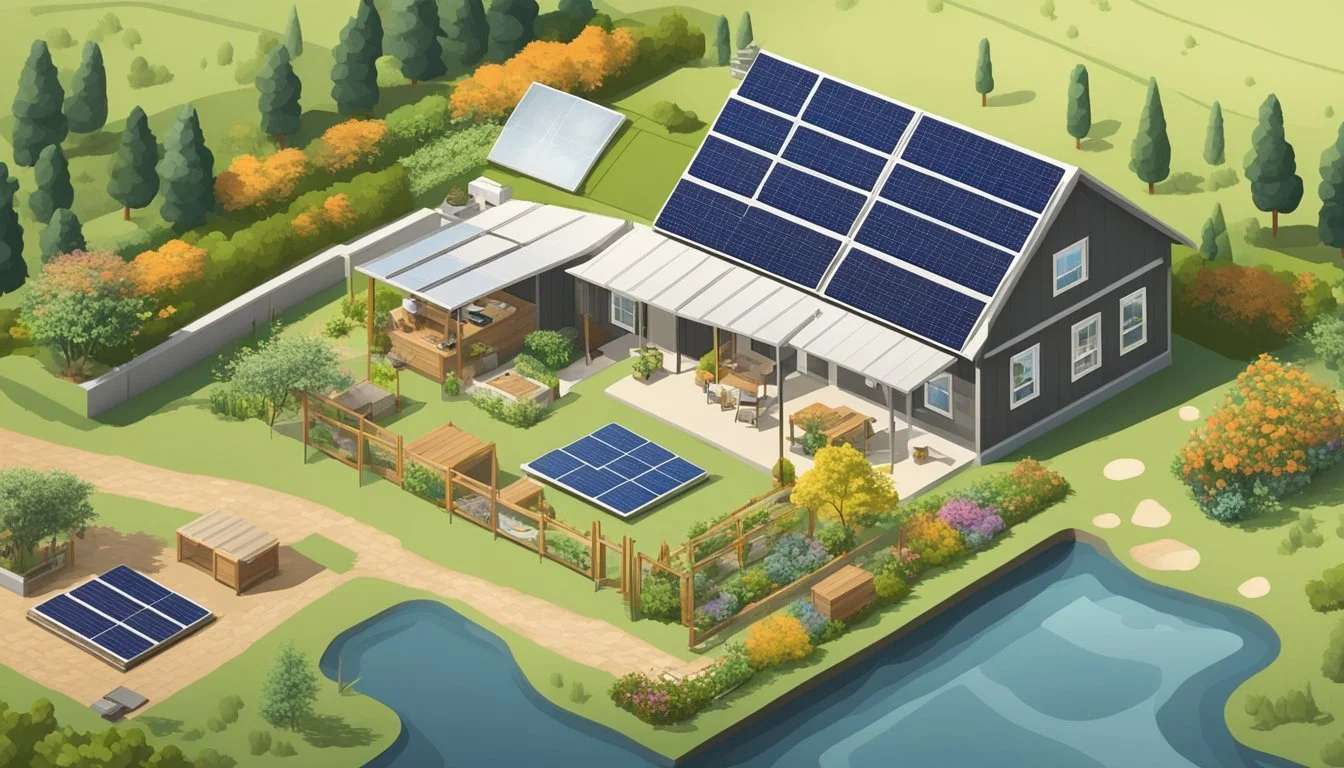Planning Your Homestead for Retirement
A Step-by-Step Guide
As retirement approaches, many individuals seek a change of pace, contemplating a lifestyle that offers both simplicity and self-reliance. Homesteading in retirement emerges as an attractive option for those eager to connect with nature and live more sustainably post-career. This lifestyle involves establishing a degree of self-sufficiency by growing one's own food and possibly raising animals, which can lead to a fulfilling and cost-effective way to spend one's retirement years.
Strategic planning is crucial for a successful transition into retirement homesteading. It entails choosing the right location, defining the scale of the homestead, and determining the types of crops and livestock that align with personal capabilities and regional climate. Prospective retirees should consider their physical abilities, financial resources, and desired quality of life when designing their homestead.
Homesteading does not merely signify a return to agrarian roots; it also embodies a commitment to lifelong learning and adaptation. For those planning a homestead for retirement, it's important to account for evolving needs over time. This may involve designing accessible infrastructure and considering proximity to healthcare services, as the journey of homesteading is as much about planning for the present as it is about preparing for the future.
Understanding Homesteading Principles
Homesteading embraces the pursuit of sustainability and self-sufficiency, particularly appealing for those approaching retirement. It is not just a way of life but a commitment to specific principles, which can lead to a rewarding retirement filled with autonomy and community connections.
Defining Self-Sufficiency
Self-sufficiency is a cornerstone of homesteading, encompassing the ability to fulfill one's needs without external assistance. Homesteaders strive to produce their own food, manage waste, and sometimes even create clothing or energy. Knowledge of agricultural practices, animal husbandry, and resource management is paramount to achieve this level of independence.
The Appeal of Homesteading in Retirement
Retirement offers the opportunity to step back from the hustle and engage in a homesteading lifestyle, which promises sustainability and a smaller ecological footprint. For retirees, this shift can mean a healthier way of life, reduction in living costs, and the satisfaction that comes with self-reliance.
Roles of Community and Neighborhood
The concept of community plays a vital role in homesteading. Cooperation among neighbors for the exchange of goods and services, sharing of knowledge, and mutual assistance strengthens communal ties and bolsters the homesteading experience. Community engagement allows homesteaders to thrive by pooling resources and expertise.
Setting Clear Homesteading Goals
Before embarking on homesteading for retirement, one must set clear, attainable goals. These goals will guide the journey, ensuring that one's efforts are directed towards meaningful outcomes. It's critical to assess personal dedication, craft a detailed dream plan, and evaluate necessary skills and knowledge.
Assessing Personal Commitment
A successful homesteader's foundation is their commitment. One must honestly assess their willingness to invest time, energy, and resources into homesteading. They should consider:
Time allocation: How many hours per week are they willing to dedicate?
Physical and mental readiness: Are they prepared for the challenges of homesteading?
Creating a Homesteading Dream Plan
Every homesteader needs a dream plan that vividly outlines their desired future. This plan should include:
Long-term objectives: What do they want to achieve in 5, 10, or 20 years?
Short-term goals: These should be specific, measurable, and tied to the long-term objectives.
Crafting this plan will cement their homesteading aspirations and lay out a path to achieve them.
Skills and Knowledge Evaluation
Homesteading requires a diverse set of skills and knowledge. Potential homesteaders should carry out a skills assessment to identify areas where they are proficient and areas that require:
Learning: What new skills do they need to acquire?
Improvement: Which existing skills can be enhanced?
This evaluation will inform their learning agenda and ensure they acquire the necessary competencies for successful homesteading.
Choosing the Right Location
When planning your homestead for retirement, selecting the right location is critical. This involves a thorough analysis of the climate, an understanding of local laws and regulations, as well as an in-depth look at property taxes.
Researching Climate and Land Management
Climate plays a pivotal role in the success of a homestead. One must consider temperature ranges, precipitation patterns, and growing seasons for sustainable land management. For instance, areas prone to droughts require strategies for water conservation, and colder climates might necessitate heated facilities for livestock.
Temperature Ranges: Look for average highs and lows throughout the year.
Precipitation: Assess rainfall or snowfall amounts and their seasonal distribution.
Growing Seasons: Determine the length of the growing seasons to plan crop rotations.
Impact of Laws and Regulations
The laws and regulations affecting a homestead vary widely based on location. Restrictions on land use, building codes, and environmental protection can influence homesteading activities. One should also be aware of any changes in legislation that could affect future expansion or practices.
Zoning Limitations: Check for what types of structures or agricultural activities are permitted.
Environmental Regulations: Understand any regulations tied to wildlife conservation, water use, or soil management.
Understanding Property Taxes
Property taxes can significantly affect the long-term affordability of a homestead. They differ based on location and the assessed value of the land and improvements. Prospective homesteaders should scrutinize potential tax exemptions for agricultural usage, which can provide substantial savings.
Tax Rates: Research local property tax rates and how they are calculated.
Exemptions and Incentives: Look for agricultural or green energy exemptions that apply to homesteading.
Selecting the optimal location requires consideration of these complex factors. Prospective homesteaders should employ meticulous research and planning to ensure their chosen location aligns with their homesteading goals and retirement plans.
Financial Planning for Homesteaders
Entering retirement requires meticulous financial planning, especially for homesteaders who aspire to maintain a sustainable lifestyle. Establishing a clear financial roadmap ensures the feasibility of a homesteading lifestyle in one's golden years.
Budgeting for a Homestead
A homesteader must begin with a comprehensive budget that captures all anticipated expenses. This includes costs for land acquisition, building materials, livestock, seeds, and equipment, as well as recurring expenses such as property taxes, utilities, and maintenance. It’s essential to have a real-live, working budget that is revisited and adjusted regularly. Consider leveraging guidance from financial self-sufficiency for homesteaders to ensure prudent financial management.
Financing and Mortgage Considerations
When it comes to financing the homestead, one may need to explore options for a mortgage. Prospective retirees should scrutinize mortgage terms, interest rates, and the impact of the loan on their retirement income. Mortgage considerations are paramount, as they can dictate the location and size of the homestead. Factors such as down payment requirements and eligibility for rural loans should also be evaluated carefully.
Optimizing Retirement and Financial Resources
Maximizing retirement resources is critical for financial longevity on a homestead. This could involve strategically tapping into pensions, 401(k)s, IRAs, or other investment income to fund homestead operations without compromising one's financial future. Homesteaders should also consider ways to generate income from their land, such as selling produce, which can complement retirement savings and reduce reliance on external financial resources.
Homestead Planning and Layout
When retiring to a homestead, careful planning and smart layout design ensure a sustainable, accessible, and energy-efficient living space. It's essential to incorporate these elements into the initial design to create a functional and comfortable retirement homestead.
Designing a Sustainable Homestead Layout
A sustainable homestead layout is fundamental for long-term success and environmental stewardship. A key factor is the integration of food production areas, such as space for a vegetable garden and small livestock, positioned to maximize sun exposure and natural water sources. Plans should include native landscaping to reduce maintenance and enhance biodiversity.
Incorporating Accessibility and Mobility Features
As individuals age, accessibility becomes paramount. Homestead designs should feature single-story living or, at the least, a main-floor bedroom to limit the need to navigate stairs. Doorways and walkways must be wide enough to accommodate mobility devices, with surfaces constructed for ease of movement and reduced trip hazards.
Energy Efficiency and Infrastructure
Energy efficiency is achieved through well-thought-out infrastructure, often starting with the home's orientation for passive solar gain. Embrace renewable energy sources like solar panels or wind turbines, and consider the installation of energy-efficient appliances and fixtures. Infrastructure must also include reliable water and waste management systems designed for sustainability and minimal environmental impact.
Managing Homestead Land and Property
Effective management of homestead land and property requires careful planning and maintenance. One must ensure the land is well-prepared, select the appropriate plants and seeds, and create a sustainable system for livestock and animal care.
Landscaping and Soil Preparation
Landscaping not only improves the visual appeal of a property but also supports plant health and water management. Key steps include:
Assessing topography: Identifying slopes and drainage patterns to prevent erosion and waterlogging.
Soil testing: This helps to determine the soil's pH and nutrient levels, which are crucial for plant health. According to Primal Survivor, embarking on homesteading is greatly aided by first understanding your land's characteristics.
Choosing the suitable species for your soil type is essential. For instance, certain plants thrive in sandy soils, while others prefer clay. Incorporate organic matter to improve soil fertility and structure—composting enriches the soil and reduces waste.
Choosing Plants and Seeds
When selecting plants and seeds for your homestead, consider these factors:
Climate adaptability: Opt for species that thrive in your region's climate to increase the likelihood of successful growth.
Seasonality: Align your plant choices with the seasons to optimize plant growth and yield.
Sustainability: MorningChores recommends focusing on water-conservation landscaping techniques such as choosing drought-resistant plants or implementing rainwater harvesting systems, ensuring that water resources are efficiently used.
Plan your planting schedule and crop rotation to maintain soil health and maximize production. The use of heirloom seeds can also be considered, as they often lead to more resilient and flavorful produce.
Livestock and Animal Care Plans
Livestock are integral to the homestead ecosystem; they provide food, manure for compost, and can contribute to land maintenance. Countryside highlights that raising animals requires daily commitment. Key considerations include:
Shelter: Design shelters that protect animals from the elements and predators.
Food and Water: Ensure a consistent and nutritious diet for the livestock, coupled with reliable water sources.
Healthcare: Regular check-ups, vaccinations, and emergency plans for illness or injury are essential.
Implement a rotational grazing system to maintain pasture health and provide animals with fresh grass, enhancing both the land and the quality of animal products.
Constructing and Maintaining Structures
In retirement, creating sustainable structures is crucial for an efficient homestead. This includes both animal housing, like coops, and facilities for year-round food production, such as greenhouses.
Building Coops and Animal Shelters
Constructing chicken coops and animal shelters requires attention to detail to ensure the safety and comfort of livestock. Coops must provide protection from predators and insulation against harsh weather. They should include features such as:
Ventilation: Proper air circulation prevents moisture build-up and maintains a healthy environment.
Accessibility: Easy entrance for cleaning and egg collection.
Durability: Using predator-proof materials like hardware cloth instead of chicken wire.
Maintenance Tips for Coops and Shelters:
Regularly inspect for structural damage.
Keep the interior dry to prevent diseases.
Replace bedding often to maintain hygiene.
Greenhouse and Other Essential Structures
A greenhouse extends the growing season, offering a controlled environment for plants. Constructing a greenhouse involves considerations like:
Orientation: Facing the longest side towards the south maximizes sunlight exposure.
Materials: Choosing polycarbonate panels for durability and better insulation compared to glass.
Maintaining Your Greenhouse:
Clean the exterior to ensure maximum light penetration.
Monitor and regulate temperature and humidity levels.
Including these structures is not merely a mark of self-sufficiency but a step towards a resilient and productive homestead. They are investments that, when expertly constructed and maintained, can provide comfort and yield long into retirement.
Homesteading Activities and Practices
Homesteading involves a variety of activities and practices aimed at self-sufficiency and sustainability. Two central components of this lifestyle are cultivating food and managing livestock.
Gardening and Harvesting Techniques
Gardening on a homestead includes planning crop rotations and soil management strategies to maintain fertility and maximize yield. Homesteaders often employ organic methods, such as composting and natural pest control. Efficient harvesting techniques are crucial to ensure that crops are picked at peak ripeness for maximum nutrition and flavor. Techniques vary from hand-picking to using scythes for larger harvests.
Key Gardening Practices:
Companion planting: Enhances growth and protects against pests.
Succession planting: Ensures a continuous harvest throughout the growing season.
Livestock Breeding and Butchering
Breeding livestock is a critical skill for homesteaders, allowing for a self-replenishing supply of meat, milk, or eggs. Selective breeding helps to strengthen desirable traits in animals, such as hardiness, fertility, and temperament. Butchering, while not always pleasant, is a necessary skill for meat production. It requires knowledge of animal anatomy and humane methods to ensure the process is as swift and painless as possible.
Livestock Breeding Goals:
Genetic diversity: Maintaining a broad gene pool prevents health issues and promotes vigor.
Sustainability: Breeding animals adapted to local conditions ensures the longevity of the homestead's livestock operations.
Sustainable Living and Resource Management
Sustainable living in retirement requires careful planning and effective management of various resources. By focusing on systems like rainwater collection, maintaining a seed inventory, and preserving food, retirees can enjoy a lifestyle that is not only self-sufficient but also mindful of the environment and future generations.
Implementing Rainwater Collection Systems
Retirees can optimize water resources by installing rainwater collection systems. These systems can range from simple barrels placed under downspouts to more elaborate setups involving roofing materials and storage tanks. By capturing rainwater, they can reduce reliance on municipal water and irrigate their gardens, which is crucial for sustainable living. It’s important to check local regulations as some areas have restrictions on rainwater harvesting.
Seed Inventory and Equipment Repair
A detailed seed inventory is essential for long-term sustainability on a homestead. Retirees should keep records of the varieties, planting dates, and harvest yields to help plan for future planting seasons. Additionally, the ability to perform equipment repair can extend the life of tools and machinery, reducing waste and saving money. They should establish a schedule for routine maintenance and learn basic repair skills.
Food Preservation: Canning and Storage
Canning and proper storage play a pivotal role in managing food resources effectively. By preserving their harvest through canning, retirees can enjoy seasonal produce year-round and build a diverse pantry, contributing to homestead self-sufficiency. They need to familiarize themselves with safe canning practices and invest in quality storage solutions to minimize food waste and ensure a stable food supply.
Learning and Adapting
When venturing into homesteading for retirement, one must be ready to learn continuously and adapt to new challenges. Staying informed through various resources is key, as is periodically reviewing what has or has not worked in past homesteading endeavors.
Reviewing Homesteading Endeavors
Homesteaders should periodically review their practices to ensure efficiency and productivity. This review process involves assessing what crops thrived, which livestock were most beneficial, and how well the homestead's design facilitated daily tasks. By evaluating these elements, retirees can make informed decisions about future changes or improvements to their homestead.
Annual Review Checklist
Crop yields and varieties: Successes and failures
Livestock health and productivity
Sustainability of homestead practices
Financial budgeting and expenses
Continuous Education Through Books and Videos
Retirement does not mark the end of one's education—especially for a homesteader. One can tap into a wealth of knowledge through books covering organic farming, animal husbandry, and sustainable living. Additionally, instructional videos provide visual guidance on more practical aspects, from constructing chicken coops to implementing solar panels.
Learning Resources
Books
"The Self-Sufficient Life and How to Live It" by John Seymour
"The Encyclopedia of Country Living" by Carla Emery
Videos
YouTube channels dedicated to permaculture techniques
Online courses offered by agricultural extension services
Preparation for Your Homesteading Journey
Planning a homestead for retirement requires meticulous preparation to ensure a smooth transition. One's foresight in contacting professionals and utilizing strategic planning tools is paramount for the creation of a self-sufficient homestead.
Contacting Real Estate Agents and Experts
When planning a homestead, one should reach out to experienced real estate agents who specialize in rural properties. These agents possess a wealth of knowledge regarding local land values, zoning regulations, and potential resources. It's beneficial to have contact information for several agents to compare insights and find the best fit for one's specific needs.
Using Checklists for Planning and Execution
Effective planning is enhanced with checklists, which serve as comprehensive guides for establishing a homestead. A well-thought-out self-sufficient homestead checklist should include tasks such as:
Assessing land suitability: Considering soil quality, water source, and climate.
Infrastructure planning: Outlining needs for housing, energy, water, and waste management.
Resource management: Ensuring sustainable practices for food supply and energy.
Homestead planning tools help one organize and execute homestead plans, with attention to detail that minimizes unforeseen complications.
Conclusion
Embarking on homesteading as a retirement plan requires a dedicated effort and consistent attention to detail. It represents a lifestyle choice that aligns with self-sufficiency, financial prudence, and a connection to nature. Enthusiasts should anticipate that the journey, while immensely rewarding, will demand significant amounts of time and resources.
It is crucial for individuals to assess their capabilities and set realistic goals. They must consider:
The physical demands of maintaining a homestead.
The initial investment and ongoing financial requirements.
The learning curve associated with acquiring new skills.
For retirees, the benefits of homesteading can include an active lifestyle, improved diet from home-grown produce, and the emotional satisfaction of building a legacy. However, they must also mind the challenges, such as navigating zoning laws and managing the changing seasons.
In essence, retirees must approach homesteading with clarity and commitment. With the right mindset and preparation, they can transform their golden years into an enriching chapter, full of growth and self-reliance.











